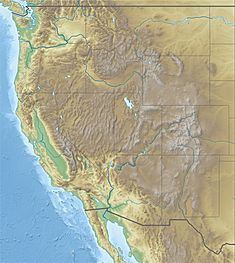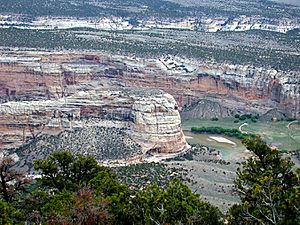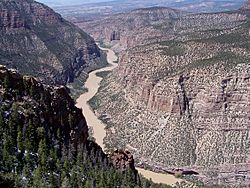Echo Park Dam facts for kids
Quick facts for kids Echo Park Dam |
|
|---|---|

Locations of the proposed dams and reservoirs
|
|
|
Location of the proposed Echo Park Dam
|
|
| Country | United States |
| Location | Northwestern Colorado |
| Coordinates | 40°32′43.45″N 109°00′30.35″W / 40.5454028°N 109.0084306°W |
| Status | Unbuilt |
| Owner(s) | U.S. Bureau of Reclamation |
| Dam and spillways | |
| Type of dam | Concrete thick arch |
| Impounds | Green River |
| Height | 529 ft (161 m) |
| Reservoir | |
| Total capacity | 6,400,000 acre-feet (7.9 km3) |
| Normal elevation | 5,500 ft (1,700 m) |
| Power station | |
| Installed capacity | 200 MW |
The Echo Park Dam was a large dam project planned in the 1950s. It was part of a bigger plan called the Colorado River Storage Project. The U.S. Bureau of Reclamation wanted to build this dam on the Green River. This river is a major branch of the Colorado River.
The dam would have been built in the Echo Park area of Dinosaur National Monument. This would have flooded much of the Green and Yampa river valleys inside the monument. Many groups who wanted to protect nature strongly opposed the dam. They saw it as a threat to a national park. They compared it to the Hetch Hetchy Dam, which was built in Yosemite National Park. This led to a big debate. In the end, the Echo Park project was stopped. Instead, the Glen Canyon Dam was built on the main Colorado River. This new dam was built in an area that was not a protected national park at the time.
Contents
Why Was the Dam Proposed?
The idea for the Echo Park Dam first came up in 1941. At that time, Dinosaur National Monument was quite small. It was only about 80 acres. Its main purpose was to protect dinosaur fossils found there.
In 1938, the monument was made much larger, growing to 200,000 acres. This new area included the canyons of the Green and Yampa rivers. These areas were not well known to the public or even to the National Park Service.
Early Support and Opposition
Initially, the Park Service did not oppose the dam plans. They had worked with the Bureau of Reclamation on other projects. These included creating recreation areas around dams like Boulder Dam.
However, by 1950, the Park Service changed its mind. Its director, Newton B. Drury, spoke out against the dam. He disagreed with Secretary of the Interior Oscar L. Chapman. Both the Park Service and the Bureau of Reclamation were part of Chapman's department.
Drury stated that reservoir projects would "destroy or impair the beauty" of national parks. He resigned in 1951, which led to criticism of Chapman. Arthur Demaray and then Conrad Wirth followed Drury as director. Wirth tried to handle the disagreement more quietly. He even suggested that Echo Park could become a National Recreation Area if it were flooded.
Public Awareness and the Colorado River Project
The public first learned widely about the dam proposal in 1950. An article by Bernard DeVoto appeared in The Saturday Evening Post. It was titled "Shall We Let Them Ruin Our National Parks?" This article compared Echo Park to the Hetch Hetchy situation. It was then reprinted in Readers Digest, reaching many people.
The Colorado River Storage Project was a big plan by the Bureau of Reclamation. It aimed to collect and use water from the upper Colorado River. States like Colorado, Wyoming, Utah, and Arizona supported the project. They wanted more control over the river's water. California used a lot of the water, and these states wanted a fairer share. Building dams higher up the river would help them control the water supply.
In 1955, the new Secretary of the Interior, Douglas McKay, withdrew support for the Echo Park Dam. This was a major turning point.
Why Glen Canyon Dam Was Built Instead
The Glen Canyon Dam was always a key part of the Colorado River Storage Project. In 1936, there was a plan to create a large national monument called Escalante. This monument would have included Glen Canyon. However, this idea was later forgotten.
The Glen Canyon area was a wild and mostly unknown place. Many people did not see it as having high scenic value. The National Park Service did not have a strong opinion on Glen Canyon. It was not a park unit. The Sierra Club, a major environmental group, was focused on saving Dinosaur National Monument. They did not realize how special Glen Canyon was until it was too late.
Sierra Club leader David Brower agreed to raise the height of the proposed Glen Canyon Dam. This decision helped save Dinosaur National Monument. However, Brower later called this his biggest mistake. He felt he had sacrificed Glen Canyon to save Dinosaur.
What Would the Project Have Looked Like?
The Echo Park project actually involved building two dams. There was the main Echo Park Dam and a smaller dam downstream called Split Mountain.
Echo Park Dam Details
The main Echo Park Dam would have been built just below Steamboat Rock. This is a huge rock formation where the Green and Yampa rivers meet. The dam would have been 529 feet high. It would have created a massive lake. This lake would have flooded the Canyon of Lodore and extended upstream through Browns Park. The Yampa River would also have been flooded.
About half of Steamboat Rock would have been underwater. Many important archeological sites, caves, and wilderness valleys would also have been lost. A Park Service report called the dam a "lamentable intrusion." It said the dam would have "particularly deplorable effects" on the monument's wilderness and geology. Power lines for the dam would also have crossed into the park. The dam was designed to produce 200 megawatts of electricity.
| Split Mountain Dam | |
|---|---|
| Country | United States |
| Location | Northeastern Utah |
| Status | Unbuilt |
| Owner(s) | U.S. Bureau of Reclamation |
| Dam and spillways | |
| Impounds | Green River |
| Height | 118 feet (36 m) |
| Reservoir | |
| Normal elevation | 5,048 ft (1,539 m) |
Split Mountain Dam Details
The Split Mountain Dam would have been 118 feet high. It was planned a few miles downstream from Split Mountain. Its lake would have backed up through Whirlpool Canyon. This would have reached the base of the Echo Park Dam.
Together, the two dams would have created calm water reservoirs throughout most of the monument. This would have affected both the Green and Yampa rivers. The Split Mountain reservoir would have flooded areas like Rainbow, Island, and Little Rainbow Parks.




